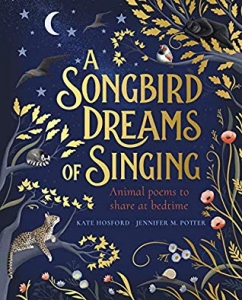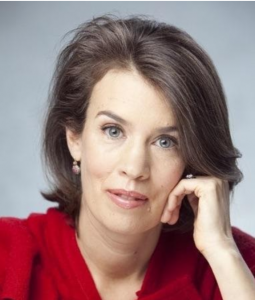New Release: A SONGBIRD DREAMS OF SINGING: POEMS ABOUT SLEEPING ANIMALS
Did you know… otters sleep while holding hands, zebra finches rehearse their songs while dreaming, worker ants take more than 250 naps per day, and frigate birds sleep while flying?
Kate Hosford’s A Songbird Dreams of Singing: Poems about Sleeping Animals is a stunning book of poems about wildlife, paired with explanations about the fascinating science behind animal sleep habits. Thank you, Kate, for taking the time to talk to Wild Things and tell us all about it!
A Songbird Dreams of Singing is such a beautiful and rare book. How did you come up with the idea of pairing poetry and scientific facts about sleeping animals?
Thank you, Sandra! I came to this topic in a roundabout way. After reading the amazing non-fiction book The Soul of an Octopus by Sy Montgomery, I decided that I would like to try to write a non-fiction poetry collection on the octopus. I did not know Sy, but the author Eliot Schrefer put me in touch with her. I wrote to Sy asking if I could write to some of her contacts at the Boston Aquarium. Instead, Sy kindly offered to host me at the Boston Aquarium where I met her, the aquarium staff, and her namesake, Sy the Octopus.
It was an unforgettable trip. I raced home and started researching further. But when I sat down to actually write the poems, I had a hard time finding my voice. I stopped writing octopus poems. However, I had learned that octopuses can change colors when they dream, which led me down the rabbit hole of animal sleep habits. Poems on this topic flowed more easily, so I just went with it.
I paired the poems with the science because I felt the poetry and prose would enhance one another, especially if they appeared on the same page.
Publishers Weekly said of you: Hosford “has a knack for translating scientific research into mesmerizing language.” I agree! You make nonfiction poetry look like a breeze. Were there any hidden challenges?
Thank you. It definitely wasn’t easy. This was my first non-fiction book, and I found research was one of my greatest challenges. So much of what I found online was incorrect, and sleep is a deceptively complicated subject. Eventually, I just had to start writing to all of the scientists directly. When I found out that songbirds rehearse their songs while dreaming, I reached out to the Daniel Margoliash lab at the University of Chicago, and ended up corresponding with Sofija Canavan, a wonderful MD-PhD student there who eventually became a scientific advisor for the book. Although there was a steep learning curve with the research, it was also one of the greatest joys of the project. A whole new world opened up to me. Soon I was analyzing antennae diagrams for sleeping ants, learning about birds who sleep while flying from a scientist in Germany, and writing to experts in Namibia about the length of a giraffe’s nap.
This is the seventh picture book in which you use lyrical texts. Does your fascination with poetry date back to your VCFA days?
I started writing poetry while at Amherst College about thirty years ago. Amherst did not have a poetry writing class, so I submitted my work for a class at Smith College and was rejected. I called the professor up in tears, and he took pity on me and let me into the class. At that time I was mostly writing free verse poems, probably because I thought that rhyme wasn’t sophisticated. I didn’t write much poetry again until my 30s, when I was reintroduced to children’s poetry and rhyming picture books after becoming a parent.
Before going to VCFA I had worked on a bunch of picture book manuscripts. Some were rhyming and some were not. During third semester, I workshopped a poetry collection called Feeding the Flying Fanellis and Other Poems from a Circus Chef with Margaret Bechard. Margaret and the workshop members all gave me the encouragement I needed to push forward with the project. Four years later, the book was published.
My fourth semester advisor, Julie Larios, really supported love of rhyme and that gave me the permission I needed to take a deeper dive into this genre, and discover many different poetic forms that I hadn’t known about before. (For those who also love rhyme, I wrote a piece recently for The Nerdy Book Club on this topic.)
After VCFA, my third semester advisor, Cynthia Leitich Smith, let me interview poets for Cynsations. This was a fantastic experience because it allowed me to ask other poets anything I wanted!
It is almost nine years since you graduated. What impact does VCFA currently have on your life and writing?
I graduated in January of 2011 with the Bat Poets, and have kept in touch with my classmates and other VCFAers through book festivals, classmate visits to New York, and the alumni mini-res weekends. I am also in a VCFA critique group in New York. Because I grew up in Vermont, it is nice to have another deep connection with my home state. My lovely agent, Victoria Wells Arms, is also a VCFA grad, and it is great to have that additional bond with her. Victoria also sold A Songbird Dreams of Singing to Running Press for me.
At the end of A Songbird Dreams of Singing, you include an impressive list of scientists with whom you consulted. What were the reactions of these scientists when you told them you were writing a picture book about sleeping animals?
They were enthusiastic about the project and patient when I needed to ask them multiple questions. The animal science community is generous and supportive—just like VCFA. I think you have to have a childlike sense of wonder to be a good scientist, and of course that is a trait that most children’s book authors have as well. So I think I was corresponding with like-minded people.
What is your favorite response to A Songbird Dreams of Singing?
My favorite response about the book was probably from Sy Montgomery, who said “The poems are such a riot! They remind me of Lewis Carroll except they are factually accurate!” I was also touched when Sofija Canavan, my science advisor at the Daniel Margoliash lab, read the poem at the end of her PhD thesis which was on zebra finches who refine their songs during their REM cycle.
Another exciting contact I made was with Jon Ablett, the senior curator of mollusca at the Natural History Museum in London. I had written a poem about a famous snail whose shell is in the museum’s collection. Last month, Jon gave me a behind-the-scenes tour of the museum, where I saw the snail’s shell, and also saw my book waiting to be filed in the museum’s mollusk library.
What do you like about Jennifer M. Potter’s illustrations?
Everything! I love her palette, and the way that she captured the tenderness of these animals while they were sleeping. Her art work is both painterly and scientifically accurate. I don’t have a favorite illustration, but I am very moved every time I look at the whales sleeping vertically, the otters holding hands, and the songbird who dreams of singing.
A Songbird Dreams of Singing: Poems About Sleeping Animals is published by Running Press Kids, November 9, 2019.
Kate Hosford graduated from Amherst College with a degree in English and Philosophy. Before becoming an author, she worked as an elementary school teacher, a social worker, and an illustrator. In 2011, she received her MFA in Writing for Children and Young Adults from Vermont College of Fine Arts. Her books are Big Bouffant, Big Birthday, Infinity and Me, Feeding the Flying Fanellis and Other Poems from a Circus Chef, How the Queen Found the Perfect Cup of Tea, Mama’s Belly, and A Songbird Dreams of Singing; Poems about Sleeping Animals. She lives in Brooklyn with her husband and two sons. Kate is represented by Victoria Wells Arms at Wells Arms Literary/HSG Agency.
For more on Kate Hosford, visit her Alumnx Success Story on the VCFA website.








